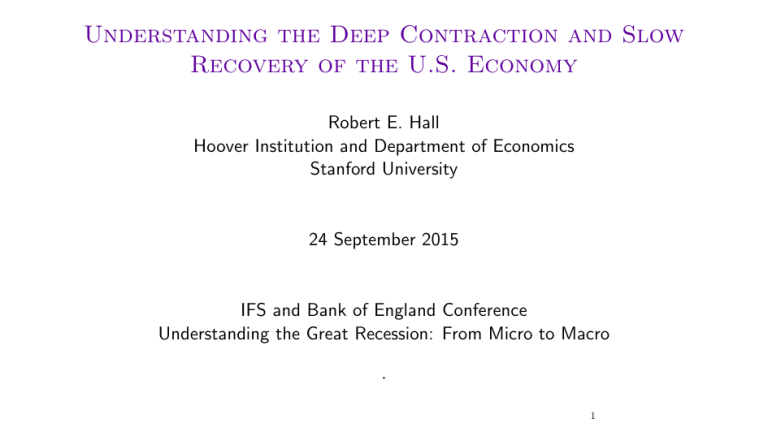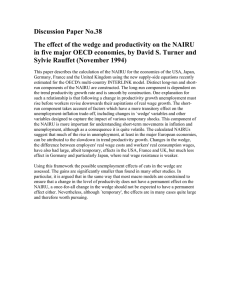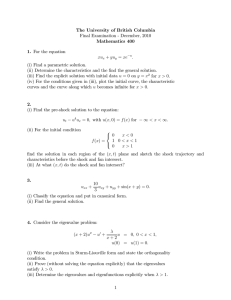Understanding the Deep Contraction and Slow Recovery of the U.S. Economy
advertisement

Understanding the Deep Contraction and Slow Recovery of the U.S. Economy Robert E. Hall Hoover Institution and Department of Economics Stanford University 24 September 2015 IFS and Bank of England Conference Understanding the Great Recession: From Micro to Macro · 1 The plan Quick review of the slump following the financial crisis of 2008 2 The plan Quick review of the slump following the financial crisis of 2008 Ideas about driving forces and propagation mechanisms 2 The plan Quick review of the slump following the financial crisis of 2008 Ideas about driving forces and propagation mechanisms A model constructed to study propagation · 2 The recent slump was similar to earlier ones Peak year Peak rate Ratio of later unemployment rate to peak rate, by number of years later 1 2 3 4 1975 8.5 0.91 0.84 0.72 0.69 1982 9.7 0.99 0.77 0.74 0.72 1992 7.5 0.92 0.81 0.75 0.72 2010 9.6 0.93 0.84 0.77 0.65 3 Real GDP, 2000-2014, Billions of 2009 Dollars 18,000 16,000 14,000 12,000 10,000 8,000 6,000 2000 2002 2004 2006 2008 2010 2012 2014 4 Real Consumption Expenditure, 2000-2014, Billions of 2009 Dollars 12,000 11,000 10,000 9,000 8,000 7,000 6,000 2000 2002 2004 2006 2008 2010 2012 2014 5 Employment, 2000-2014, Thousands of Workers 150,000 140,000 130,000 120,000 110,000 100,000 90,000 2000 2002 2004 2006 2008 2010 2012 2014 6 Unemployment, 2000-2014, Percent of Labor Force 12 10 8 6 4 2 0 2000 2002 2004 2006 2008 2010 2012 2014 7 Percent of Working-Age Population in the Labor Force, 2000-2014 68 67 66 65 64 63 62 61 60 2000 2002 2004 2006 2008 2010 2012 2014 8 Average Real Earnings per Household, 2009 Dollars, 1990-2014 80,000 70,000 60,000 50,000 40,000 30,000 20,000 10,000 0 1990 1993 1996 1999 2002 2005 2008 2011 9 Index of Capital Services, 2007 = 1, 2000-2014 1.2 1.1 1.0 0.9 0.8 0.7 0.6 0.5 0.4 2000 2002 2004 2006 2008 2010 2012 2014 10 Index of Total Factor Productivity, 2007 = 1, 2000-2014 1.10 1.05 1.00 0.95 0.90 0.85 0.80 0.75 0.70 2000 2002 2004 2006 2008 2010 2012 2014 11 Labor share 1.30 1.25 1.20 1.15 1.10 1.05 1.00 0.95 0.90 0.85 1989 1992 1995 1998 2001 2004 2007 2010 2013 12 Business Earnings as a Ratio to the Value of Capital 0.25 0.20 0.15 0.10 0.05 0.00 2000 2002 2004 2006 2008 2010 2012 13 Driving forces Some potentially exogenous 14 Driving forces Some potentially exogenous Others clearly induced by a process outside the model, such as rising discounts and frictions resulting from collapse of house prices · 14 Driving force #1: Labor-force participation Not generally considered in the fluctuations literature 15 Driving force #1: Labor-force participation Not generally considered in the fluctuations literature Decline of about 3 percentage points after 2007; not the result of the slack labor market 15 Driving force #1: Labor-force participation Not generally considered in the fluctuations literature Decline of about 3 percentage points after 2007; not the result of the slack labor market Continuation of a trend starting in 2000, not the result of demographic shifts · 15 Driving force #2: Capital wedge Difference between the return to capital and the safe real interest rate 16 Driving force #2: Capital wedge Difference between the return to capital and the safe real interest rate Comprises agency frictions, risk premium, and taxes · 16 Measuring the wedge qt = κ kt −1 +1 kt−1 17 Measuring the wedge qt = κ 1 + rk,t = kt −1 +1 kt−1 1 πt + (1 − δt )qt+1 pk,t+1 qt pk,t kt 17 Measuring the wedge qt = κ 1 + rk,t = kt −1 +1 kt−1 1 πt + (1 − δt )qt+1 pk,t+1 qt pk,t kt ft = rk,t − rf,t · 17 The capital wedge for two values of the adjustment cost κ 20 20 18 18 16 16 14 14 12 12 10 10 8 8 6 6 4 4 2 2 0 0 1990 1993 1996 1999 2002 2005 2008 2011 1990 (a) κ = 0 1993 1996 1999 2002 2005 2008 2011 (b) κ = 2 · 18 Driving force #3: Extra discount Discounts for risky payoffs seem to rise far more than the return to capital during and after crises · 19 The S&P Risk Premium, 1960 through 2012 30 25 20 15 10 5 0 ‐5 1960 1965 1970 1975 1980 1985 1990 1995 2000 2005 2010 20 BBB-Treasury Bond Spread 5.0 4.5 4.0 3.5 3.0 2.5 2.0 1.5 1.0 0.5 0.0 2000 2002 2004 2006 2008 2010 2012 2014 21 Driving force #4: Total factor productivity Fernald concludes that the decline was not the result of the crisis · 22 Driving force #5: Shift in product demand induced by contraction in lending Shifts from different sources all result in “multiplier” responses 23 Driving force #5: Shift in product demand induced by contraction in lending Shifts from different sources all result in “multiplier” responses No important shift in government purchases, the usual variable 23 Driving force #5: Shift in product demand induced by contraction in lending Shifts from different sources all result in “multiplier” responses No important shift in government purchases, the usual variable But a major decline in household consumption as a result of tightening lending standards and declining collateral 23 Driving force #5: Shift in product demand induced by contraction in lending Shifts from different sources all result in “multiplier” responses No important shift in government purchases, the usual variable But a major decline in household consumption as a result of tightening lending standards and declining collateral Some part of the decline in business investment also resulting from tightening standards · 23 Driving force #6: Product-market wedge In the New Keynesian view, the wedge rises in slumps 24 Driving force #6: Product-market wedge In the New Keynesian view, the wedge rises in slumps Another view: Financially constrained firms raise markups · 24 Propagation mechanisms Propagation occurs when the effect of a driving force lasts longer than the force itself · 25 Mechanism #1: Depletion of the capital stock This turns out to be the leading source of propagation · 26 Mechanism #2: Unemployment dynamics Because job-finding rates remained high even during the recent slump, leading labor-market models seem to imply that little propagation occurs because of the time it takes displaced workers to find new jobs 27 Mechanism #2: Unemployment dynamics Because job-finding rates remained high even during the recent slump, leading labor-market models seem to imply that little propagation occurs because of the time it takes displaced workers to find new jobs But studies of the experiences of displaced workers shows length periods of lower employment 27 Mechanism #2: Unemployment dynamics Because job-finding rates remained high even during the recent slump, leading labor-market models seem to imply that little propagation occurs because of the time it takes displaced workers to find new jobs But studies of the experiences of displaced workers shows length periods of lower employment A high incidence of very brief interim jobs seems to be at least part of the reconciliation 27 Mechanism #2: Unemployment dynamics Because job-finding rates remained high even during the recent slump, leading labor-market models seem to imply that little propagation occurs because of the time it takes displaced workers to find new jobs But studies of the experiences of displaced workers shows length periods of lower employment A high incidence of very brief interim jobs seems to be at least part of the reconciliation The slow but steady decline of high rates of long-term unemployment is consistent with this view · 27 Mechanism #3: The Zero Lower Bound At the lower bound, the real interest rate is minus the expected rate of inflation 28 Mechanism #3: The Zero Lower Bound At the lower bound, the real interest rate is minus the expected rate of inflation In the Great Depression, expected inflation turned negative, so real rates reached high levels 28 Mechanism #3: The Zero Lower Bound At the lower bound, the real interest rate is minus the expected rate of inflation In the Great Depression, expected inflation turned negative, so real rates reached high levels In the recent slump, expected inflation remained roughly constant 28 Mechanism #3: The Zero Lower Bound At the lower bound, the real interest rate is minus the expected rate of inflation In the Great Depression, expected inflation turned negative, so real rates reached high levels In the recent slump, expected inflation remained roughly constant Even so, the bound elevated unemployment for as long as it lasted, more than six years · 28 Inflation Expectations and Forecasts 4.5 4.0 3.5 Michigan 3.0 2.5 Professional forecasters TIPSs 2.0 1.5 1.0 0.5 0.0 2003 2005 2007 2009 2011 2013 29 Effects of the ZLB Almost all models portray the ZLB as opening a gap between output supply and demand and labor supply and demand 30 Effects of the ZLB Almost all models portray the ZLB as opening a gap between output supply and demand and labor supply and demand Gapology seems realistic but leaves mysteries about how markets respond to congestion resulting from excess supply 30 Effects of the ZLB Almost all models portray the ZLB as opening a gap between output supply and demand and labor supply and demand Gapology seems realistic but leaves mysteries about how markets respond to congestion resulting from excess supply And it’s hard to reconcile gap-based unemployment with DMP-based unemployment 30 Effects of the ZLB Almost all models portray the ZLB as opening a gap between output supply and demand and labor supply and demand Gapology seems realistic but leaves mysteries about how markets respond to congestion resulting from excess supply And it’s hard to reconcile gap-based unemployment with DMP-based unemployment The ZLB propagated the declines in product demand resulting from financial events—the multiplier for these declines was much higher than normal, according to the demand-gap model · 30 Model suited to studying persistence Medium term; 2-year periods 31 Model suited to studying persistence Medium term; 2-year periods Exact stochastic solution 31 Model suited to studying persistence Medium term; 2-year periods Exact stochastic solution Non-stationary; models unfiltered data · 31 Properties Four-state Markov process for the 6 driving forces 32 Properties Four-state Markov process for the 6 driving forces TFP and labor force evolve as trended random walks with increments a function of the 4-valued random state 32 Properties Four-state Markov process for the 6 driving forces TFP and labor force evolve as trended random walks with increments a function of the 4-valued random state Levels of other driving forces functions of the state 32 Properties Four-state Markov process for the 6 driving forces TFP and labor force evolve as trended random walks with increments a function of the 4-valued random state Levels of other driving forces functions of the state States constructed from principal components of the driving forces · 32 The States of the Model State TFP growth Discount Laborforce growth Wedge Periods in state 1 H L L L 1952-53, 1954-55, 1958-59, 1962-63, 198889, 1990-91, 1996-97, 1998-99 2 H L H L 1956-57, 1960-61, 1964-65, 1966-67, 196869, 1970-71, 1986-87, 2000-1 3 L H L H 1982-83, 1992-93, 1994-95, 2004-5, 20067, 2008-9, 2010-11, 2012-13 4 L H H H 1972-73, 1974-75, 1976-77, 1978-79, 198081, 1984-85, 2002-3 33 Transition Matrix and Ergodic Distribution To state From state Ergodic probability 1 2 3 4 1 0.38 0.50 0.13 0.00 0.21 2 0.38 0.38 0.00 0.25 0.22 3 0.14 0.00 0.71 0.14 0.33 4 0.00 0.14 0.29 0.57 0.24 34 Persistence of the States 0.9 Excess probability of being in state 0.8 0.7 1 2 4 3 0.6 0.5 0.4 0.3 0.2 0.1 0 0 2 4 6 8 10 Years 35 Responses of Driving Forces to Their Own Shocks 0.014 0.045 0.040 0.010 0.005 0.012 0.035 0.000 0.020 0.015 Expected value Expected value 0.025 0.008 0.006 ‐0.005 ‐0.010 ‐0.015 ‐0.020 0.004 0.010 ‐0.025 0.002 0.005 0.000 ‐0.030 0.000 0 2 4 6 ‐0.035 0 8 2 4 Years 6 8 Years (a) Productivity 0 2 4 (c) Discount 0.005 0.000 ‐0.005 ‐0.010 ‐0.015 ‐0.020 0 2 4 6 8 Years (d) Wedge 6 Years (b) Labor force Expected value Expected value 0.010 0.030 36 8 Model specification One-sector growth model with adjustment costs for investment 37 Model specification One-sector growth model with adjustment costs for investment Time to build requires that investment and hiring are determined in the period before they take effect 37 Model specification One-sector growth model with adjustment costs for investment Time to build requires that investment and hiring are determined in the period before they take effect In the asset-pricing equations, marginal utility one period ahead is elevated by the discount driving force, so investment and hiring decisions are made with elevated discount 37 Model specification One-sector growth model with adjustment costs for investment Time to build requires that investment and hiring are determined in the period before they take effect In the asset-pricing equations, marginal utility one period ahead is elevated by the discount driving force, so investment and hiring decisions are made with elevated discount The zero-profit condition for recruiting effort in the labor market indexes the future benefit to the employer by the marginal revenue product of labor · 37 The zero lower bound in the model When the ZLB binds, the DMP zero-profit condition drops out 38 The zero lower bound in the model When the ZLB binds, the DMP zero-profit condition drops out Instead, the asset pricing condition for the safe real rate holds that rate at a constant · 38 Productivity Shock 9 9 8 8 Consumption Consumption 7 Response to initial shock Response to initial shock 7 6 Capital 5 4 3 2 Employment 6 4 3 2 1 1 0 0 ‐1 Capital 5 Employment ‐1 0 2 4 6 8 0 Years 2 4 6 8 Years (a) Market rate (b) Fixed rate · 39 9 9 7 7 Response to initial shock Response to initial shock Discount Shock 5 3 1 Employment ‐1 Capital ‐3 Consumption 0 2 4 6 Employment 5 3 Consumption 1 Capital ‐1 ‐3 8 0 Years 2 4 6 8 Years (a) Market rate (b) Fixed rate · 40 4.5 4.5 4.0 4.0 3.5 3.5 Consumption Consumption Response to initial shock Response to initial shock Labor-Force Shock 3.0 2.5 Capital 2.0 Employment 1.5 1.0 Capital 3.0 2.5 2.0 Employment 1.5 1.0 0.5 0.5 0.0 0.0 ‐0.5 ‐0.5 0 2 4 6 0 8 2 4 6 8 Years Years (a) Market rate (b) Fixed rate · 41 Financial-Friction Shock 0.5 0.5 Employment 0.0 Employment Capital Response to initial shock Response to initial shock 0.0 ‐0.5 Consumption ‐1.0 ‐1.5 ‐2.0 ‐0.5 ‐1.0 Capital ‐1.5 ‐2.0 ‐2.5 ‐2.5 ‐3.0 ‐3.0 0 2 4 6 8 Consumption 0 Years 2 4 6 8 Years (a) Market rate (b) Fixed rate · 42 Product-Market Wedge Shock 0.0 Capital ‐0.2 Consumption ‐0.3 Employment ‐0.1 Response to initial shock Response to initial shock 0.0 Employment ‐0.1 ‐0.4 ‐0.5 Capital ‐0.2 ‐0.3 Consumption ‐0.4 ‐0.5 ‐0.6 ‐0.6 0 2 4 6 8 0 Years 2 4 6 8 Years (a) Market rate (b) Fixed rate · 43 Product-Market Demand Shock 1.3 Response to initial shock Response to initial shock 1.3 0.8 0.3 Employment ‐0.2 0.8 Employment Consumption 0.3 Capital ‐0.2 Capital Consumption ‐0.7 ‐0.7 0 2 4 6 8 0 Years 2 4 6 8 Years (a) Market rate (b) Fixed rate · 44 Contributions of driving forces to standard deviations of 2-year log changes in the endogenous variables Driving force Interest rate Endogenous variable Consumption Capital Employment Market 0.015 0.019 0.009 Fixed 0.016 0.021 0.030 TFP Market 0.014 0.019 0.009 Fixed 0.031 0.005 0.096 Discount Market 0.007 0.008 0.017 Fixed 0.010 0.010 0.026 Labor force Market 0.002 0.002 0.001 Fixed 0.009 0.007 0.034 Financial friction Market 0.001 0.001 0.002 Fixed 0.002 0.001 0.006 Product market wedge Market 0.001 0.002 0.001 Fixed 0.004 0.001 0.014 0.030 0.023 0.032 Government purchases Actual data 45 Propagation Ratios by Driving Force, Interest Rate Regime, and Endogenous Variable Driving force Interest rate Endogenous variable Consumption Capital Employment Market 3.5 449.2 2.4 Fixed 1.5 2.5 0.1 TFP Market 1.8 0.9 0.3 Fixed 0.3 0.6 0.1 Market 3.3 17.5 1.8 Fixed 1.5 2.5 0.8 Market 2.3 0.8 0.3 Discount Labor force Financial friction Fixed 0.8 0.8 0.2 Market 1.1 0.9 0.3 Fixed 0.8 0.8 0.1 Product market wedge Market 1.9 0.9 0.3 Fixed 0.3 0.7 0.1 Government purchases 46




